March 2019 – Volume 21, Issue 2
In This Issue
-
Flanigan’s EcoLogic: The iVision of Dr. Patrick Soon-Shiong
-
Fueling Microgrids – Comments from San Diego
-
The Energy Cloud
-
German GHG Emissions Update
-
Renewable Natural Gas – RNG
-
Competitions for Buildings, Cooling, and Cleaning Up Ocean Plastics
-
Loop’s Reusable Packaging
-
Cognitive Functioning in Schools

Flanigan’s EcoLogic: The iVision of Dr. Patrick Soon-Shiong
Impressed and in awe do not adequately relate the profundity of my emotions. This 67-year old man before our eyes is a force, a gentle, beaming soul who no doubt has both boundless energy and creativity… and lots of smarts. Like Elon Musk, Soon-Shiong was born and raised in South Africa. He’s a Chinese-American surgeon, a leading entrepreneur in medicine, data transfer, and now distributed energy resources and with assets in the $9 billion range… a philanthropist. Michael, Jay, and I heard him speak at the South Bay Cities Council of Governments General Assembly. Dr. Soon-Shiong explained to us that his career covers a) the human body, as the biological factory… against life-threatening diseases, b) energy sources, notably the sun, air, and water as energy sources for the future, and c) connectivity, creating a new social network of truthful news. These areas link together in the tapestry of a rich life.
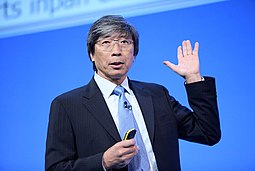
Dr. Soon-Shiong
The Human Body: Soon-Shion began as a doctor. As a UCLA surgeon he performed the first pancreatic transplant. He’s a leading diabetes and cancer researcher. In 1991, he left UCLA to start a diabetes and cancer biotechnology firm… and literally made billions selling pharmaceuticals. He’s published over 100 scientific papers and has amassed 92 U.S. and 138 international patents on technologies and medicines.
NantHealth was founded by Soon-Shiong in 2007 to provide fiber optic, cloud-based data infrastructure to share healthcare information. He now has more than 200,000 miles of fiber cables nationwide. In 2013, he founded NantOmics to develop cancer drugs based on protein kinase inhibitors. This form of cancer treatment re-energizes “natural killer” cells within our bodies that attack cells with errors. As we age, Soon-Shiong explains, we have less of them and they are weaker. Thus our bodies are more susceptible.
Distributed Energy: Now Dr. Soon-Shiong is heavily into distributed energy and energy storage in particular. In September 2018 his company NantEnergy announced the development of a zinc air battery with a projected cost of $100/kWh… less than one third of the cost of lithium ion batteries. He’s bought firms – including a division of Sharp – to develop microgrids and to install his preferred storage battery chemistry. His energy systems are currently powering 3,000 sites in nine countries including 113 microgrids in Africa and over 1,000 cell tower sites globally.
Connectivity: In 2018, Dr. Soon-Shiong gained significant local notoriety when he bought the struggling Los Angeles Times. This was big, and as he explains, driven by his belief that for communities to thrive, that they need local news organizations. They inform and bind us. The LA Times was about to lose its entire, 300-person news desk until he bought the paper and moved its news desk from downtown LA to new facilities in El Segundo in record time. He talks about how paper sales have declined and has their profitability and about the new era, and that it is online. He’s recently created a TV news show… called the LA Times! And yes, he is an owner of the LA Lakers so he can periodically be seen courtside chatting with Lebron between periods.
Quote of the Week
“Loop brings back the old milkman model where products are delivered to your door at the same time that empties are picked up, washed, refilled, and readied for delivery to another customer.”
Fueling Microgrids – Comments from San Diego
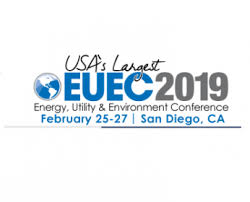 Last week I traveled south to San Diego to speak at EUEC 2019, the annual Energy Utilities and Environment Conference, this year at the San Diego Convention Center. I’d been asked to speak about EcoMotion’s experience in Monterey County developing microgrids on school sites there.
Last week I traveled south to San Diego to speak at EUEC 2019, the annual Energy Utilities and Environment Conference, this year at the San Diego Convention Center. I’d been asked to speak about EcoMotion’s experience in Monterey County developing microgrids on school sites there.
I was struck by the utilitarian nature of the conference, far from the net zero crowd that I am used to. The conference was about utilities’ solutions and pragmatic means for compliance. An earlier panelist from the United Kingdom talked about “The Energy Trilemma…” the triple challenge faced by utilities and their regulators in providing cost-effective, reliable, and environmentally sensitive power. He presented the merits of hybrid solar/combined-cycle gas plants, and prepping them for hydrogen. Others made disparaging remarks about the Clean Power Plan. I was shocked to hear that Germany’s thrust toward renewables is back-firing, and that its emissions have increased.
The microgrid panel featured an array of technology solutions. Asim Hussain emphasized that emissions from “Bloom Boxes” are actually less than those of solar when backed-up with grid power through net energy metering. True, until the grid is green! An Engie official presented a thoughtful set of remarks underscoring the will of the people, the politics and policies involved with fostering distributed energy resources and microgrids. Policy is following technology in the microgrid space.
Also on the panel was a recent PhD from Solar Turbines, a company that manufacturers gas-powered turbines. Another panelist began by stating that he’d really like to buy a case of beer for the panelists, to really kick this issue around together. A self-professed environmentalist from the State of Washington, his opinion that small nuclear reactors could well serve microgrids startled me. Enamored he was by the power density of a nuclear reactor. Give me another beer.
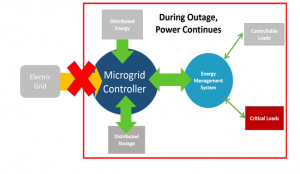 My job was to present the Santa Rita Union School District microgrid project. EcoMotion guided solar plus storage project there from its inception. The result, six microgrids that can island and that can become Powered Emergency Response Centers (PERCs) in the event of prolonged outages and calamity. The PERCs are carbon-free, fully financed, and provide for robust campus resilience. In February, Microgrid Knowledge selected the SRUSD PERC project for its Microgrid 2019 Greater Good Awards. The Grid-Connected Microgrid Category features 11 projects from around the country.
My job was to present the Santa Rita Union School District microgrid project. EcoMotion guided solar plus storage project there from its inception. The result, six microgrids that can island and that can become Powered Emergency Response Centers (PERCs) in the event of prolonged outages and calamity. The PERCs are carbon-free, fully financed, and provide for robust campus resilience. In February, Microgrid Knowledge selected the SRUSD PERC project for its Microgrid 2019 Greater Good Awards. The Grid-Connected Microgrid Category features 11 projects from around the country.
The Energy Cloud
 Just as we’re also getting used to the concept of the Technology Cloud, get ready for the Energy Cloud. It represents the energy transition that is well underway and the rise of the disruptive energy platform. A Navigant Consulting paper provides a useful update on the evolution of the energy cloud.
Just as we’re also getting used to the concept of the Technology Cloud, get ready for the Energy Cloud. It represents the energy transition that is well underway and the rise of the disruptive energy platform. A Navigant Consulting paper provides a useful update on the evolution of the energy cloud.
Distributed Energy Resources (DERs) will continue to grow exponentially in the next 5 – 10 years. The Energy Cloud is being driven by distributed generation, energy efficiency, demand-side management, demand response, smart metering, behind-the-meter energy management, and social media. It will drastically change the way utilities interact with their customers, increasing the complexity of utility operations. Increasingly sophisticated customers want self-service as well as new products and services.
The grid of the future draws many parallels to the Technology Cloud that distributes computing power and data storage around a vast and carefully controlled network. Users draw on the services they need, when they need them. Users pay for the value of the resources they actually use. In the Technology Cloud, they have greater control over costs and great freedom to choose, rather than being locked in with one vendor.

The Energy Cloud represents the same kind of structure for electricity, intelligent management of power consumption. We are in the midst of a technology shift in how electricity is generated and managed… from large-scale power plants to a multi-directional network that relies on small-scale distributed generation. The Energy Cloud is interactive. It allows customers to take from the grid and to provide power to it.
There’s something to be said about the parallel tracks of the Technology Cloud and the Energy Cloud. When analyzing the Technology Cloud, some established players in the information technology field and utility businesses saw their roles diminish while major aspects of the Cloud’s functions were handled by new entities. And in both clouds, it’s the management of the network that creates the greatest value. That turns the utility industry – known for its steady returns based on its physical assets (power plants, transmission, and distribution lines) — on its head.
German GHG Emissions Update

Angela Merkel, Chancellor of Germany
Germany has been heralded for its progressive stance on curbing greenhouse gas emissions, and its corresponding surge toward renewable power. Just this past year, renewables overtook coal as the country’s number one source of power. But recently I’ve heard of trouble in Germany’s green transition. Has Angela Merkl’s shift to renewables back-fired?
While German emissions dropped steadily in the 1990s, largely due to the closure of grossly inefficient industries in East Germany, a chink in the progress of Germany’s Energiewende (“energy transition”) began to appear around 2010 when German emissions reversed the downward trend and began to rise slightly. While still well below its 1990 emissions, its experts now acknowledge that it will not succeed in fulfilling its 2020 stretch goal of a 40% reduction below 1990 levels.
Is Germany failing? Let’s see: It’s well ahead of the European Union goal of a 20% reduction by 2020. It has the same national product as Canada but with two-thirds of the emissions. Germany’s emissions in 2013 were 23% lower than 1990 levels. By 2017, Germany had achieved a 27.7% reduction. It is anticipated to reach 32% below 1990 levels by 2020. At the same time, the world’s GHG emissions became 61% higher than the 1990 baseline levels.
A recent poll suggests that 73% of Germans favor an early retirement of coal-fired capacity. So in January of this year, reacting to its slip in climate protection progress, and to get back on track, and after a 21-hour marathon negotiating session, Germany developed a plan to shut down all of its 84 coal-fired power plants in the next 19 years, by 2038. “It’s also an important signal for the world that Germany is again getting serious about climate change: a very big industrial nation that depends so much on coal is switching it off,” said Claudia Kemfert, professor of energy economics at DIW Berlin.
Renewable Natural Gas – RNG
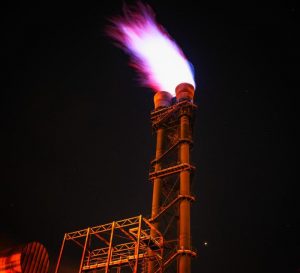 Southern California Gas is the largest natural gas distribution company in the United States. It serves gas to 21.8 million customers across 24,000 square miles. It also provides gas to many of the state’s power gas-fired plants. Fracking has given natural gas a big black eye. The leak at SoCal Gas’s Aliso Canyon underground storage facility was catastrophic. These events and more have fueled attacks on natural gas use and have raised the pitch for beneficial electrification… a movement to convert virtually all natural gas uses to all-electric including stoves, hot water heaters, furnaces, and even CNG buses.
Southern California Gas is the largest natural gas distribution company in the United States. It serves gas to 21.8 million customers across 24,000 square miles. It also provides gas to many of the state’s power gas-fired plants. Fracking has given natural gas a big black eye. The leak at SoCal Gas’s Aliso Canyon underground storage facility was catastrophic. These events and more have fueled attacks on natural gas use and have raised the pitch for beneficial electrification… a movement to convert virtually all natural gas uses to all-electric including stoves, hot water heaters, furnaces, and even CNG buses.
In the midst of the intense carbon controversy between natural gas and electricity advocates, this past week SoCalGas (SCG) announced its plan to replace 20% of its traditional natural gas supply with renewable natural gas (RNG) by 2030. This is part of its vision to be the greenest natural gas utility in North America. SoCalGas is seeking regulatory authority to implement a “broad renewable natural gas procurement program” with the goal of 5% of its gas to be RNG by 2022. SoCal Gas also recently requested regulatory authorization to sell RNG to its customers for their homes through a voluntary program with a price premium.
So what is RNG? It’s a clean fuel produced from our waste streams – from sewers, food waste, dairy and ag wastes… that can be used for heating, cooking, fueling trucks and buses. RNG reduces emissions because it takes more emissions out of the air than it emits as an energy source. Actually, it prevents emissions from being released into the air. In 2016, California Governor Brown signed a bill aimed at reducing the emission of short-lived climate pollutants including methane from organic sources. The law requires that 40% of methane from sewage treatment plants, landfills and agriculture be captured. That’s RNG.
Today, more than 80% of methane emissions in California come from agriculture, dairies, wastewater treatment plants, and other organic sources. A 2016 University of California at Davis study calculated that California has the potential to produce nearly 100 billion cubic feet of RNG each year. A U.S.DOE study reports that the United States currently produces 1 trillion cubic feet of RNG annually. This is expected to increase to 10 trillion by 2030.
SoCalGas started infusing RNG into its pipelines in 2018 using the RNG from an anaerobic digester built and operated by the waste hauling company CR&R. It uses organic wastes from green waste bins for the digester, with the resulting fuel used for 400 collection trucks. In January of 2019, Calgren — a bio gas producer — began flowing RNG from a dairy digester pipeline cluster. Calgren will collect methane from 12 Tulare County dairies preventing 130,000 tons of greenhouse gas emissions each year, equivalent to taking 25,000 cars off the road. There are 24 dairy digester projects in operation or development in California.
Competitions for Buildings, Cooling, and Cleaning Up Ocean Plastics
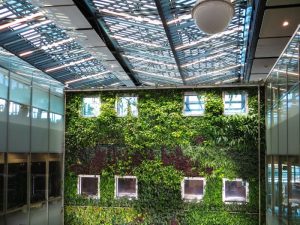 Building Efficiency: The Buildings of Excellence competition was announced this past week by Governor Andrew Cuomo. At his direction, NYSERDA launched the competition with $30 billion in incentives to encourage construction and operation of low and zero-carbon emitting buildings. There will be three rounds of competition each funded with $10 million. The competition will award up to $1 million per project. The first round is focused on multi-family projects; applications are due in June.
Building Efficiency: The Buildings of Excellence competition was announced this past week by Governor Andrew Cuomo. At his direction, NYSERDA launched the competition with $30 billion in incentives to encourage construction and operation of low and zero-carbon emitting buildings. There will be three rounds of competition each funded with $10 million. The competition will award up to $1 million per project. The first round is focused on multi-family projects; applications are due in June.
The Governor’s office reports that 59% of New York State’s emissions are from the building sector. Using a combination of financial incentives and recognition, the Buildings of Excellence competition will show that carbon-free buildings can be profitable, attractive and affordable. They will eventually become part of the New York State Energy Conservation and Construction Code.
The competition is part of the Governor’s Green New Deal and his plan to completely eliminate the state’s carbon footprint. In January, Cuomo funded renewables with $1.2 billion in the state budget. New York State’s clean energy standard calls for renewables to generate 70% of the state’s power by 2030.

Cooling Efficiency: The Global Cooling Prize was established by Rocky Mountain Institute with a host of partners including the Department of Science and Technology of the Government of India. The Prize is seeking residential cooling solutions that result in five times less climate impact than today’s standard room air conditioners. There’s up to $3 million in prize money designed to gain an impact, up to 5,900 TWh per year in annual saved energy by 2050. The prize could prevent up to 100 GT of CO2 e by 2050 while enhancing living standards for people in developing countries around the globe.
The international competition was launched in November 2018. Its impetus is that by 2030 over half the world’s population will live in hot climates with increased exposure to potentially dangerous heat conditions. Residential cooling demand is expected to increase by a factor of three globally and by a factor of five in developing countries. Approximately 4.5 billion room air conditioning units will be in use globally by 2030, compared to 1.2 billion today. All the while, about 14% efficiency has been reached by the most advanced air conditioning technology, and most air conditioners are less than 8% efficient.
 Ocean Plastics: Sadly, the oceans are considered the world’s largest landfill. Our oceans contain some 150 million metric tons of plastics, with 8 million more tons added each year. That’s about a New York City garbage truck load per minute. In a few years, there will be a pound of plastic for every three pounds of fish in the ocean. A 2016 study concluded that without remedial action, there will be more plastic in the ocean than fish by 2050.
Ocean Plastics: Sadly, the oceans are considered the world’s largest landfill. Our oceans contain some 150 million metric tons of plastics, with 8 million more tons added each year. That’s about a New York City garbage truck load per minute. In a few years, there will be a pound of plastic for every three pounds of fish in the ocean. A 2016 study concluded that without remedial action, there will be more plastic in the ocean than fish by 2050.
To tackle this stark reality, National Geographic and Sky Ocean Ventures are teaming up to make 2019 an important year for resolving the ocean plastic crisis. Plastics impact nearly 700 species in our ocean, from the tiniest plankton to the largest whales. Plastic has been found in 100% of sea turtles.
In early March and to respond to the ocean plastic crisis, these organizations launched the Ocean Plastic Innovation Challenge. It will award up to $500,000 in prize money and potentially $1 million in investments to teams that can develop solutions to the plastic crisis. While 2018 was a landmark year for raising awareness about plastic pollution in our oceans, the high-profile Boyan’s Slat Ocean Cleanup system had to return to port for repairs before doing any clean-up work.
Loop’s Reusable Packaging
Loop is a small company that has compelled more than two dozen of the world’s biggest brands to begin testing reusable packaging. Loop has a blue-chip roster of participating companies. The company is piloting a new system of high-quality packaging that can be returned and refilled again and again. Sound familiar?
Loop changes the ownership model of the packaging from the consumer to the producer. Developed by TerraCycle, a Trenton, New Jersey company that made a name for itself by returning hard-to-recycle wastes-like juice boxes — into new products. Loop partners include Proctor & Gamble, Nestle, Pepsico, Unilever, Mars, Clorox, Coca-Cola, and dozens of smaller brands. Loop service will launch this spring in two markets, in the suburbs of Paris and in the New York region. Initially about 300 products will be available in durable, reusable containers, many created especially for Loop.
Cognitive Functioning in Schools
 EcoMotion’s recent HVAC upgrades for a small school district in Spreckels, California resulted in more efficient units that are generating cost savings, as well as considerably more classroom ventilation. The reason? More sophisticated controls that allow for remote monitoring and control of each individual HVAC unit also have sensors that measure CO2 levels in classrooms.
EcoMotion’s recent HVAC upgrades for a small school district in Spreckels, California resulted in more efficient units that are generating cost savings, as well as considerably more classroom ventilation. The reason? More sophisticated controls that allow for remote monitoring and control of each individual HVAC unit also have sensors that measure CO2 levels in classrooms.
The new systems are programmed to ventilate when classroom CO2 levels exceed 1,000 PPM. As a result, the new HVAC units’ fans are on far more often than before the retrofit. The school district is saving energy and improving student health… but some teachers have complained about the HVAC being on much more often and being noisy.
My daughter Skye has been a research coordinator for cognitive functioning studies in buildings. Her colleagues’ work at Harvard’s School of Public Health has drawn attention. The bottom line: Workers function better in well-ventilated spaces. There’s lots of research that substantiates this claim.
In 2007, the “landmark” National Research Council study titled, “Green Schools: Attributes for Health and Learning” was published. Its authors found extensive information and evidence to demonstrate that the school building is foundational to student success. A school building can adversely or positive affect students’ well-being both in the short term and over the cause of their academic career.
 In 2011, the U.S. EPA determined that more than 60,000 schools – 46% of public schools — have environmental conditions that contribute to poor Indoor Environmental Quality (IEQ). This sector, and its facilities, have been woefully underfunded. Many, many school buildings – as EcoMotion can attest – are badly in need of deep upgrades and retrofits. Common environmental factors in school buildings include indoor air pollution, pests, mold, pesticides, radon, asbestos, lead, inadequate lighting, and elevated noise levels. Students can be negatively affected by chronic exposures to these elements.
In 2011, the U.S. EPA determined that more than 60,000 schools – 46% of public schools — have environmental conditions that contribute to poor Indoor Environmental Quality (IEQ). This sector, and its facilities, have been woefully underfunded. Many, many school buildings – as EcoMotion can attest – are badly in need of deep upgrades and retrofits. Common environmental factors in school buildings include indoor air pollution, pests, mold, pesticides, radon, asbestos, lead, inadequate lighting, and elevated noise levels. Students can be negatively affected by chronic exposures to these elements.
As studies have reinforced, “children are not little adults.” They have unique needs, sensitivities, and vulnerabilities. It’s a time of rapid growth, hormonal changes, intense learning, and critical neurological and social development. Children have developing lungs with narrow airways. They breathe in larger volumes of air than adults relative to their body size. Childhood asthma is the leading cause of absenteeism in schools, resulting in 13.8 million missed school days in 2015 according to the Centers for Disease Control and Prevention.
By the time a student graduates from high school, he or she will have spent 15,600 hours inside a school. Schools have four times as many occupants per square foot as office buildings. In the past 80 years, 250,000 public schools have been consolidated into 80,000 schools. Fully 31% of schools use portable classrooms. There are many aging schools over 50 years old… susceptible to environmental exposures from building decay, water damage, mold growth, poor plumbing, and legacy pollutants. As a society, we expect 21st century learning in 20th century schools.
Harvard’s researchers on healthy buildings state that environmental exposures can impact student health, student thinking, and student performance. Student health relates to the overall health of a school and its occupants; student thinking involves short-term impacts on cognitive foundation including attention, comprehension, annoyance, and irritability; while student performance relates to successful, long-term academic performance of students. Each of these are in focus.
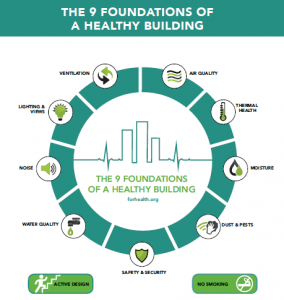
9foundations.forhealth.org
What constitutes a healthy school building? The Healthy Buildings team at Harvard concentrates on the nine foundations of a healthy building. Let’s focus on one, ventilation:
Ventilation is the defined as the flow of outside air into a building. As we all know, ventilation ensures a comfortable, healthy, and productive indoor environment. But a study in the American Southwest found that 87 of 100 classrooms had ventilation levels below recommended healthy levels. ASHRAE – the American Society of Heating, Refrigeration, and Air Conditioning Engineers – recommends a minimum classroom ventilation rate of 15 cubic feet per minute per student to keep CO2 levels below 1,000 PPM. Studies have shown that school routinely exceed this recommended level. One study of schools in Texas showed that 21% of the schools studied had CO2 levels in excess of 3,000 PPM.
Studies have found that higher ventilation rates and low CO2 levels can positively affect office workers. One study of office workers showed that when ventilation rates were doubled, causing CO2 levels to drop from 1,400 to 950 ppm, participants had higher cognitive functioning scores. Studies with students resulted in similar findings: Their attention is limited in classrooms with higher CO2 levels and lower ventilation rates. Researchers observe a 5% decrement in the power of attention in poorly ventilated classrooms… greater fatigue, impaired attention span, loss of concentration, lower test scores, and less focus on lectures for university students.

